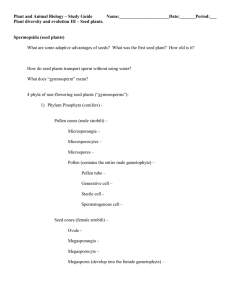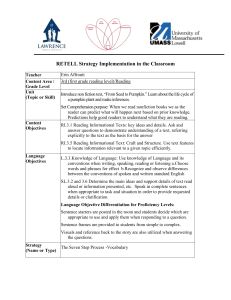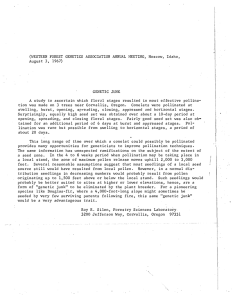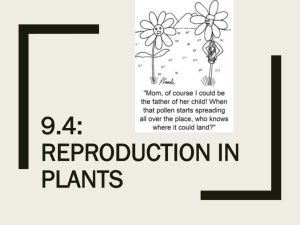Document 12787137
advertisement
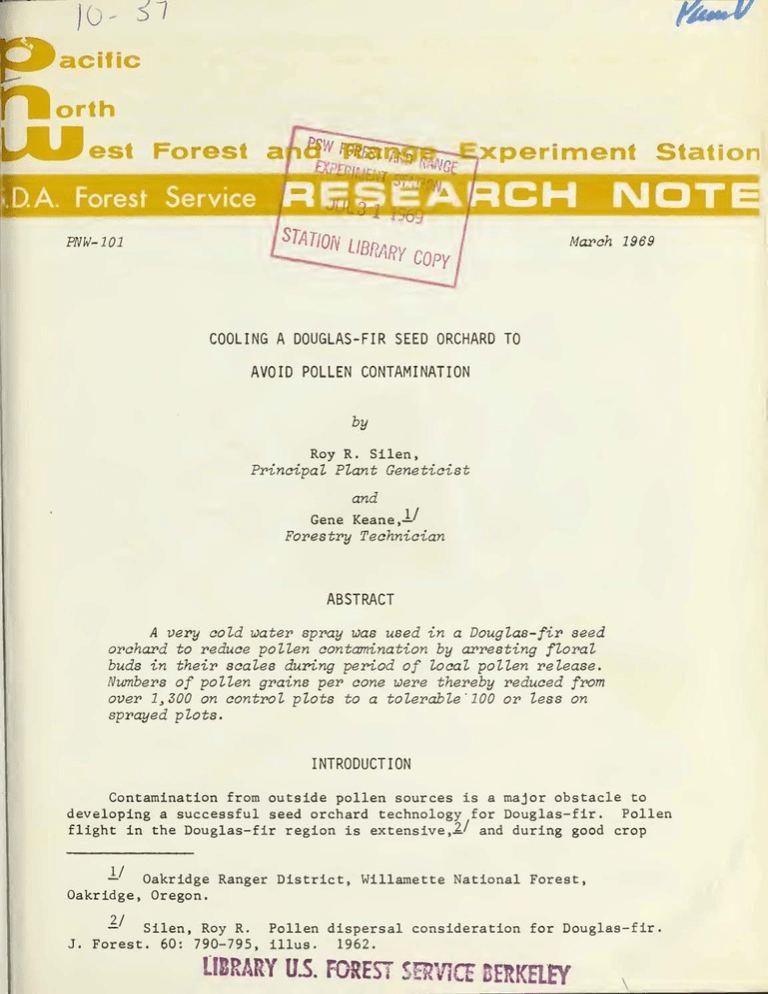
}()-- :51 est Forest Station Marach 1969 PNW-101 COOLING A DOUGLAS-FIR SEED ORCHARD TO AVOID POLLEN CONTAMINATION by Roy R. Silen, Principal Plant Geneticist and Gene Keane ,1.1 Forestry Technician ABSTRACT A very cold water spray was used in a Douglas-fir seed orchard to reduce pollen contamination by arresting floral buds in their scales during period of local pollen release. Numbers of pollen grains per cone were thereby reduced from over 1 300 on control plots to a tolerable ' 100 or less on sprayed plots. 3 INTRODUCTION Contamination from outside pollen sources is a major obstacle to developing a successful seed orchard technology for Douglas-fir. Pollen flight in the Douglas-fir region is extensive,£/ and during good crop ll Oakridge Ranger District, Willamette National Forest, Oakridge, Oregon. 11 Silen, Roy R. Pollen dispersal consideration for Douglas- f ir. J. Forest. 60: 790-795, illus. 1962. [IBRARY U.S. FOREST SERVICE BERKElEY \ years , pollen counts are high over all the region. For example, sampling of four nonflowering seed orchards during 1966 in Oregon and Washington showed counts averaging from 2,864 to 6,941 pollen grains deposited per square inch.dl Such high densities of unwanted pollen greatly dilute pollination between seed orchard trees and reduce the genetic value of seed orchard seed. Among unsuccessful methods explored prior to 1968 for reducing Douglas-fir pollen contamination were pollen-free buffer zones, moving seed orchards to other regions, exploiting expected phenologi­ cal differences from bringing high elevation selections to lo~ ele­ vation orchards, and delaying year of heavy flowering.!/ 11 ~/ In 1968, an ad hoc Northwest Pollen Problems Committee was organized by researchers and seed orchardists to explore methods to control the inflow or the pollinizing effectiveness of outside pollen.ll This paper reports on one of five new approaches suggested. The assigned approach was to explore the possibility of carrying as much outside pollen as possible to the ground in a water spray. The senior author, noting that high elevation snowmelt was the water source for the orchard designated for the test, suggested that the primary intent of the study be changed to arresting development of the floral buds with very cold water. In earlier bud abortion studies, he had cooled individual branches for 10 days with melting ice and practically halted all shoot development for this period. If floral bud burst could be delayed by cold from a water spray as well as from evaporation through the 2-week period that most local pollen is released, contamination could be largely avoided. Orchard trees then could interpollinate in relative freedom from outside pollen. This report covers a low-cost exploration of this concept. dl Silen, Roy. Sampling of pollen contamination within Northwest seed orchards. IFA Tree Improvement Newsletter No. 7, pp. 5-13. Jan. 1968. i/ See footnote 2. 21 Silen, Roy R. Effect of altitude on factors of pollen con­ tamination of Douglas-fir seed orchards. J. Forest. 61: 281-283, illus. 1963. ~/ Silen, Roy R. Pollen contamination and isolation. Improvement Newsletter No. 1, pp. 15-16. No~ 1964. ll IFA Tree Silen, Roy R. Attempts at practical control of pollen con­ tamination. (Abstr.) Proceedings of Western Forest Genetics Ass. meeting, Corvallis, Oreg. Aug. 1968. 2 MATERIALS AND METHODS The water spray ixperiment was conducted a t the U.S. Forest Service Heather Seed Orchard~ --the only Northwest seed o rchard with an ample supply of piped water in 1968. The 10-acre or cha rd is 1ocated at a 2,600-foot elevation on a high bench above Salt Creek, ·s miles east of Oakridge, Oregon. Salt Creek is a glaciated val ley onl y a few mile s from the crest of the Cascade Range, with canyon walls reaching 5,200 feet and forested with native Douglas-fir. Pollen contamination counts made in the orchard on 2 previous years indicated a hig h Douglas-fir pollen count of about 6,300 grains per square inch. Although the cr o p of floral buds on Douglas-firs around the orcha r d was heavy, flowering in the orchard was light but considered adequat e f or the study. The study was designed with three paired 1/3-acre plots of abou t 100 trees, one sprayed and the other nnsprayed in e a c h pair. About equal numbers of ramets from each o f the 15 clones were on each p l o t . This provided the opportunity to sample the same clones on each pl o t. Spraying began in the first 1/3-acre plot on March 18 (all buds tig ht), in the second plot on April 1 (floral buds swelling), and in the third plot on April 15 (10 percent of floral buds burst). Spraying continued until May 7 on all plots, providing c1 6-, 4-, and 2-week spr a y period. The intent of the staggered dates was to bracket various portions of the growth period to see how many weeks of spraying might be required to achieve control over b ud opening. Six o v erhead - t yp ~ 3prinkler s were used on each sprayed plot. Although somewhat wasteful, these sprinklers produced enough spray below the arcing jet to maintain a film of water on all the plants during spraying without mechanic a l injury from t he force of the jet. Maximum temperatures were record ed among the folia g e on each plot. Temperature records were also kept of wat er at the spra J heads. Trees were sprayed whenever the air temperature exceeded 50° F. From April 10 to May 15, pollen from surrounding forest stands was sampled in the orchard during dry weather periods on 64 vaseline­ coated slides. Each faced one of eight compass points a nd was held 0 at a 45 angle atop a 4-foot stake. Pollen was c ounted on five loca­ tions on each slide, each location was one-tenth inch on a side pro­ viding a 1/20-square-inch area sampl e d pe r sl id e. ~/ Th e authors gr a tefully ac know l e dge fin anc i al su ppor t f or f i eld phases of the study by Region 6 , For e s t Serv i ce, U.S. Department of Agriculture. 3 Twenty male and 20 female buds were observed for differences in stage of development twice a week on every plot. To estimate effec­ tiveness of the water spray in reducing foreign pollen, we collected three female conelets from each plot on April 30 and May 7. Each conelet was dissected under a binocular microscope, and pollen grains were counted on every fourth scale. This method gave a direct estimate of amount of contaminating pollen. Significance of differences between pollen counts of conelets from corresponding clones on sprayed and unsprayed plots was tested by an analysis of variance. On April 27, pollen from elongated catkins was collected in the sprayed plot to compare its viability with pollen from shedding catkins of the same clones in the unsprayed plot. Germination was tested within 2 hours of collection, by use of a 0.15-percent H202 test developed at the Forestry Sciences Laboratory at Corvallis.2/ Other records taken included continuous temperature and humidity in a standard weather shelter, notes on the effectiveness of spraying, soil erosion, percent of buds unburst, pollen release of the male cat­ kins, icing observations of orchard ramets during low temperature periods, and filled-seed count of sampled cones. Spraying was halted May 7 when we observed that pollen shed was virtually complete on the trees surrounding the orchard. A heavy frost had occurred that night, killing most of the conelets in the orchard. Pollen was still shedding at higher elevations, so half the rema1n1ng conelets in the plots were enclosed in pollination bags that day to isolate them from external pollen. Cones that developed on the plots were collected on September 5, and counts of filled seed were recorded. RESULTS Despite frost damage that seriously reduced seed yield, the study showed considerable promise for use of cold water spray to slow floral development and reduce seed orchard pollen contamination. Pollen density recorded in 1968 was extremely heavy. During the rain-free periods from April 10, when pollen was first observed, to May 17, an average of about 12,980 grains of Douglas-fir pollen per square inch was deposited on the vaseline-coated slides. This was 11 This test has not been previously reported, although it has become widely employed for Douglas-fir by Northwest geneticists because Its effectiveness has been verified by actual of its rapid response. seed set data. 4 almost double the density of corresponding average counts of 6,338 and 6,234 made in the orchard during 1965 and 1966. Peak deposition in 1968 was on April 30 when 2,850 grains per square inch were deposited in a single 24-hour period. Production from the extremely light pollen crop within the orchard was a negligible part of this count. Cold water spray markedly arrested but did not halt floral devel­ opment. The influence on bud development by warm periods was obvious, even on sprayed plots. By May 7, plots sprayed on March 18 and April 1 were estimated to be 9.5 to 12.0 days behind the unsprayed control plots (table 1). Floral development was retarded as much by 4 weeks of spraying as by 6, indicating no advantage for the longer spraying period. Floral development on the plot sprayed for 2 weeks was delayed only 4.8 days, an indication that more than 2 weeks of spraying was necessary. Development of female conelets on April 29 at peak of local pollen deposition illustrates the extent of retardation from the cold water spray. On that date, 70 percent of the 40 observed female buds on two control plots were open to receive pollen, compared with only 17.5 per­ cent of 40 female buds on the two plots sprayed for 4 or 6 weeks. Not only were male buds retarded from cold water spraying but no pollen was shed from opened male buds as long as spraying was continued. Even though more male buds had opened by May 7, wetness completely prevented shedding. Viability of pollen from water-sprayed male cat­ kins tested just as high as from catkins on the unsprayed plots, both testing over 90 percent viable. May 7 pollen counts on the female conelets provided a quantitative estimate of the level of control over contaminating pollen. Table 2, giving pollen counts on the three plots, shows maximum reduction of foreign pollen on the two plots where spraying began on April 1 and March 18. These dates were 2 and 4 weeks, respectively, ahead of local pollen release. Spraying begun on April 15 was too late to be as effective because female conelets were not delayed enough. Pollen counts on the female conelets of sprayed and unsprayed plots differed in the order of 18:1 for March 15, 36:1 for April 1, and only 3:1 for April 15. The differences between counts of sprayed and unsprayed plots were statistically highly significant (F=47.97 based on 1 and 24 d.f.). The reduction in pollen to levels generally below 100 grains per conelet by the longer spray periods, however, is the significant accomplishment since such levels of contamination are acceptable. Cone yields were greatly reduced by extensive frost damage to cone buds. As buds opened on the unsprayed plots, there were four frosts with minimum temperatures from 28° to 26° F. Spraying preserved devel­ oping female conelets within the sprayed p l ots , but about 25 percent of the conelets were killed on unsprayed plots. Early on the morning of 5 ~ Table !.--Difference in stage of female conelet development on May ? between control plots and plots sprayed with cold water Stage of Sf development March 18 to May 7 (6 weeks) Sprayed I Unsprayed April 1 to May 7 (4 weeks) Sprayed 1 Unsprayed April 15 to May 7 (2 weeks) Sprayed I Unsprayed - - - - - ln_Eercent - - - - - - - 1.15 -- 45 -- 0 Burst (5)1/ 15 -- 10 -- 10 Open (9)1/ 80 -- 30 -- 15 Maximum ( 13 )1/ -- 5 15 10 75 25 Appressed (17)1/ -- 75 -- 70 -- 60 Turning (20)1/ -- 20 -- 20 -- 15 Unburst - - - - - - In days - - - - - - ­ Estimated delay in developmentl./ 9.5 12.0 4.8 1.1 Basis is 20 ~'s labeled for observation on each plot . 11 Figures in parentheses represent normal lapsed developmental period in days to middle of stage. Data are from observations by senior author of average female bud development during two seasons at Corvallis, Oregon . ll From weighing numbers of ~'s in each stage by normal day value for each stage . Table 2.--Pollen grains counted on scale s of female cone l etsll on plots unsprayed and sprayed wi t h cold water f or 6, 4, and 2 weeks before May ?11 Spray period Unsprayed plot (u) Number grains per Sprayed plot (s) Ratios of grains per !f. conelet !f. Ratio u/s conelet March 18 to May 7 1,391 77 18: 1 April 1 to May 7 1,349 37 36:1 April 15 to May 7 2,164 733 3:1 ll Each figure is the mean pollen count on 3 female conelets observed on May 7 when local trees had shed their pollen. 11 Counts made on April 30 were similar but only about a third as high. Both were used in the analysis of variance cited in the text. May 7, temperatures dropped to 26° F., killing most of the conelets in unsprayed plots and all but 29 in 6- and 4-week sprayed plots. No cones remained in the 2-week sprayed plot. The 29 remaining cones, 14 of which were bagged on May 7, developed normally, proving that even 6 weeks of spraying did not alter subsequent cone or seed development. Cones were collEcted on September 5, and seed yields determined. Comparative seed yields are shown in table 3. An 8- to 10-fold reduction in contaminating pollen thus is indicated from spraying. It was not possible to make comparisons representing the same clones in equal proportions nor to directly compare data by paired plots as we did with pollen sampled on conelets. Such clouds on the data are probably minor, the main shortcoming being the variance within small sample size left by the frost of May 7. For instance, on the sprayed plot, a single cone was observed with 27 filled seed, almost as many as were found in the other 13 of the 14-cone sample. A single such cone in so small a sample raised the percent seed set f rom a 2.2 average per cone to a 7.7 average and changed the comparison from an 18-fold to an 8-fold change due to cold treatment. The former figure approaches ratios in­ dicated by earlier pollen sampling data. 7 Table 3 .--Seed yieZds f rom trees on pZots sprayed 6 and 4 weeks and from unsprayed control pZots Number of cones Number of seeds per cone Range Percent filled seeds per cone Sprayed plots (bagged May 7) 14 4.1 0-27 7.7 Sprayed plots (not bagged) 15 22.4 2-40 44.0 Unsprayed orchard 26 41.1 14-87 64.8 Sample from The other 15 cones surviving the frost also developed, yielding an average of 22.4 seeds per cone. This indicates that subsequent pollination was effective for sprayed cones. It also indicates that considerable pollen from higher elevations was effectively reaching the orchard, a problem that is accentuated in narrow valleys but not considered serious for the majoritJ of Northwest orchards which are located in extensive flat areas.lQ Water temperatures at the sprayheads varied from 35° F. minimum to 48° F. maximum during the 6-week spray period. The rise occurred primarily when sun shown on the 700 to 1,000 feet of aluminum pipe needed to reach the plots. Leaf temperatures near the buds reached 56° F. even with continuous spraying on some hot days. Good insula­ tion, or burying of the pipes, could have provided cooler water on the warmest days when conelet development was fastest. The floral buds, long held back by the cool water, developed appreciably in a 3­ day warm period of April 27 through April 29, when afternoon tempera­ tures reached 74° to 81° F. Spraying gave some protection against frost damage as floral buds began to swell and open. No loss of cone buds occurred on the sprayed plots through four early frosts down to 26° F., whereas about a quarter of the unsprayed cone buds died in these frosts. However, protection by spraying was only negligible against the 26° F. frost on May 7 when buds were fully expanded. Records made on May 9 showed 70 percent of floral buds dead on unsprayed and 83 percent on sprayed ~I 8 See footnote 5. plots. The entire 83-percent loss occurred on sprayed plots from the single 26° F. temperature, whereas only an estimated 45 percent died that night on unsprayed plots which had already had mortality from earlier frosts. Spraying might give important control of frost damage for the majority of seed orchards which are located at low elevations where late spring frosts seldom are as severe as 26° F. About 20 percent of the ramets in the sprayed plot were severely bent or broken from the weight of a 1/2-inch ice coating formed from having the sprinklers on all night of May 6 to 7. As the pollen counts were made, we observed that a watersoaked condition was common in the stigmatic area. We thought this might cause oxygen deficiencies and interfere with seed and pollen develop­ ment; however, seed yields on cones from sprayed plots were higher than expected and watersoaking in stigmatic areas was not detrimental. DISCUSSION AND CONCLUSIONS The concept of slowing floral development by cold water appears the most promising of the many approaches explored to date toward practical control of pollen contamination in Douglas-fir seed orchards. Though some development occurred under treatment conditions of this study, female buds cooled by a water spray for a month prior to local pollen release remained in their scales long enough to reduce the amount of pollen contamination to a tolerable level. An even greater reduction might be possible if water temperatures are kept lower. Presumably, water temperature is the main variable. Evaporative cool­ ing is another variable that might somehow be made more effective as well. Expected adverse effects of continued wetting were not found. No soil erosion occurred in the seed orchard. Seed developed normally after 6 weeks of spraying. Pollen produced by ramets grow­ ing in sprayed plots appeared normal in germination tests. The spraying appeared beneficial in providing some frost protection but detrimental in causing some ice damage during severe frosts. A serious limitation of this approach is that no other orchard in the Northwest now has an adequate supply of cold water. Prodigious amounts of water would be required to spray large orchards with over­ head-type sprinklers for a 4-week period. However, water needs might be reduced through use of intermittent mists or fine sprays. Such reduced needs might be met with well water, which is usually in the 40° to 50° F. range during this period. 9 As with agricultural crops, artificial control of microenviron­ ments on a commercial scale, such as this concept represents, will probably require an extensive developmental effort. These results encourage such an effort. 10
